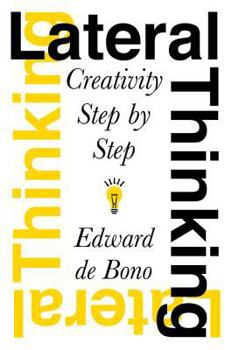Lateral Thinking: Creativity Step by Step
Select Format
Select Condition 
Book Overview
The first practical explanation of how creativity works, this results-oriented bestseller trains listeners to move beyond a vertical mode of thought to tap the potential of lateral thinking.
Format:Paperback
Language:English
ISBN:0060903252
ISBN13:9780060903251
Release Date:February 2015
Publisher:Harper Perennial
Length:300 Pages
Weight:0.57 lbs.
Dimensions:0.8" x 5.4" x 8.0"
Customer Reviews
4 ratings
Very insightful book.
Published by Thriftbooks.com User , 15 years ago
I'm puzzled by the negative reviews on this book. The author is very lucid. Some critics, which you can find on wikipedia, note that he hasn't attempted to "prove" his position. That's not the author's point. By definition, he isn't indulging in linear or logical thought. If he were to concede to his critics, he wouldn't write the book. The critics have missed the point. His examples supply, not proof, but circumstantial evidence supporting his theory. In a court of law, sometimes all you have is circumstantial evidence. Since when is such evidence inadmissible in an argument anymore than it is in the courts of old? It's been used for centuries with the courts and with famous mathematical statements known as "conjectures." Pure mathematical thought doesn't say anything about the world because it is constituted of tautologies. If you want to say something about the world, as the author does, you are by definition departing from purely formal thought and therefore purely formal rigor in your demonstrations. I thought the homely examples by the author were good. For example, he discusses the feature in European liquor manufacturers of fruit contained in a bottle of liquor. How did it get there? Was the bottom attached? No. There is no visible weld. Was the fruit pushed inside? No. It's too wide for the bottle neck. Solution? Insert the small bud of the fruit into the bottle and let it grow there. The glass operates as a small green house; therefore, it won't interfere with the growth of the fruit. With regard to the conundrum PO, the author is explicit on page 225. "Logic could be said to be the management of NO. . .The concept of lateral thinking is insight restructuring and this is brought about through the rearrangement of information. Rearrangement is the basis of lateral thinking and rearrangement means escape from the rigid patterns established by experience. The rearrangement process is incorporated in the concept of the (re) laxative. The laxative is a rearranging device. It is the means whereby one can escape from established patterns and create new ones. The concept of the laxative is crystallized into a definite language tool. The language tool is PO. . .The whole concept of lateral thinking is concentrated in the use of this language tool. Lateral thinking could be said to be the management of PO just as logical thinking is the management of NO. . .PO is to lateral thinking what NO is to logical thinking." My only misgiving with the author is his seeming overemphasis of the use of tilde in its use in logic. Maybe he's right. However, proof by the use of contradiction or excluded middle isn't the only proof used in formal thought. There is other forms of proof. Yet, he insists all of logic can be summed up as a manifold use of the operator "tilde." If I recall, Russell and Whitehead failed in trying to reduce all of formal thought to a few logical operators, let alone one operator, such as the tilde,
Creativity in a Bottle
Published by Thriftbooks.com User , 16 years ago
In my view, this is the best of the de Bono series of more than 30 books. It is as advertised: A step-by-step introduction to the art and science of creative thinking. It shows the reader with a staple of de Bono's -- his graphs and diagrams - how to get over the threshold from just ordinary (right brain thinking) or "linear thinking" to (left brain thinking) or "lateral thinking," that is to pure creativity; and most important, how to consistently find the "launch pad" to ones own creativity. Critical to the organization of this book and to making his points here (the same as in his other books), is giving the reader a basic understanding of how the mind works. This provides the framework for setting up and recognizing the special situations in which ones creativity is most likely to come into play. Like, others in the de Bono series, these techniques work so well that it is scary.
It will not turn you into creative genius, but it can open some doors...
Published by Thriftbooks.com User , 18 years ago
"With lateral thinking one goes on generating as many approaches as one can even after one has found a promising one." [Lateral Thinking] Human mind is during the school education instructed how to think vertically. Meaning, how to evaluate alternatives, how to pick the right one and how to proceed from premises to conclusions. However, it is only seldomly instructed how to create alternatives, how to generate ideas - and that's were this book is helpful. Kind regards, Mario.
Useful who like to think.
Published by Thriftbooks.com User , 25 years ago
It's a book written on serious things in a very light style. Sometimes we are very near to hear a tellerstory and soon after we are close of a professional dealing with mind and differents ways to learn. Its very interesting and usefull for professors, teachers and persons that love work thinking.






